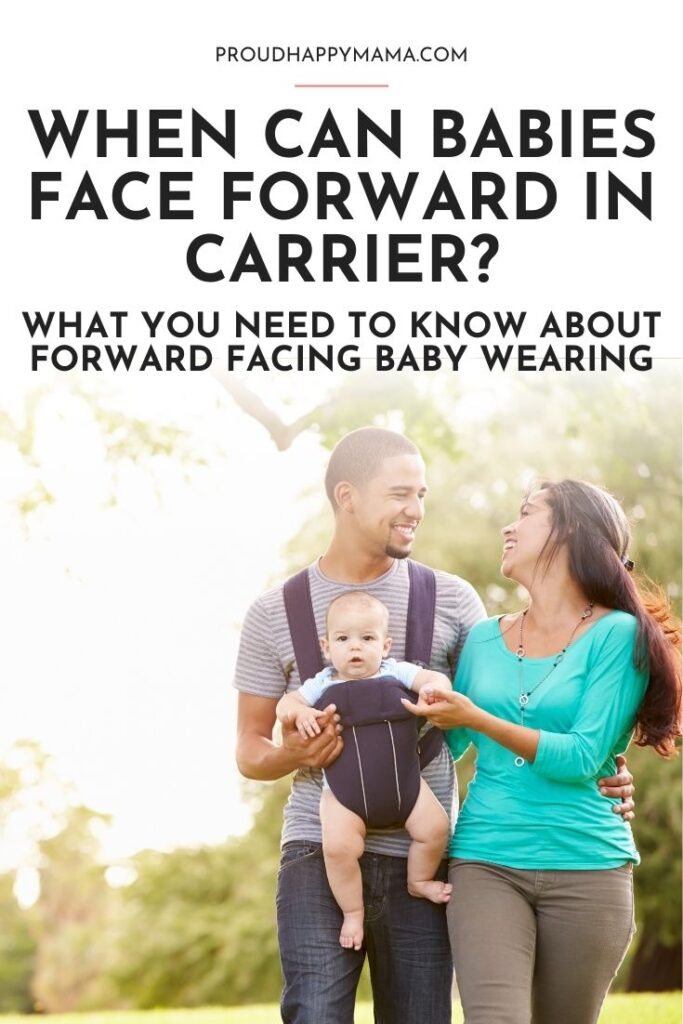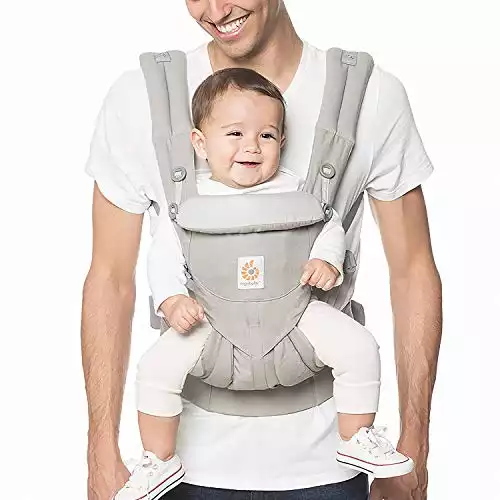When Can Your Baby Face Forward in Carrier?
As your baby gets older, you might wonder when can my baby face forward in a carrier.
Many babies love this position because it allows them to face the world rather than their parents.
The front-facing out position was once one of the biggest controversies in the babywearing world; some parents were adamant against it. Opinions divided people, and manufacturers disagreed strongly.
Nowadays, the controversy isn’t so significant as more manufacturers create baby carriers that purposefully allow babies to face forward safely.
Many babywearing experts now support this carrying position, so long as you use a hip-healthy carrier!
So, if you’re wondering when can a baby face forward in a carrier, here is what you need to know.
And if you love our guide on when to forward carry, make sure you also check out these great reviews for the best baby carriers for petite moms, best baby carriers for plus size moms, and baby carriers vs wraps!
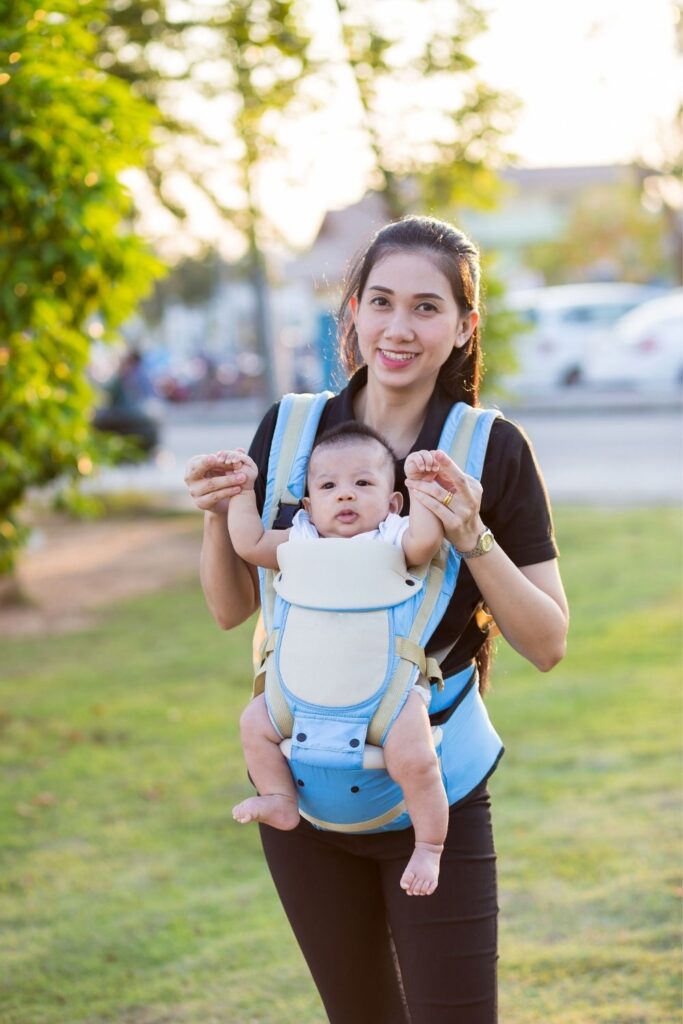
When Can Babies Face Forward in Baby Carrier?
When can babies face forward in a carrier? When your baby is at least four to six months old, can support their own head and meet size requirements for the carrier.
Babies younger than four to six months should only be used in a baby carrier in the inward-facing position. They need to have proper head, neck, hip, and bottom support.
Baby carrying positions depend on the age and stage of development. Babies are ready to face forward when they pass the bobblehead phase – you know, when your baby’s head will randomly fall backward and pop up again.
Your baby must have strong neck muscles to support her head, which happens between four and six months old.
This milestone varies for all babies, so when to face the baby forward doesn’t have a perfect answer.
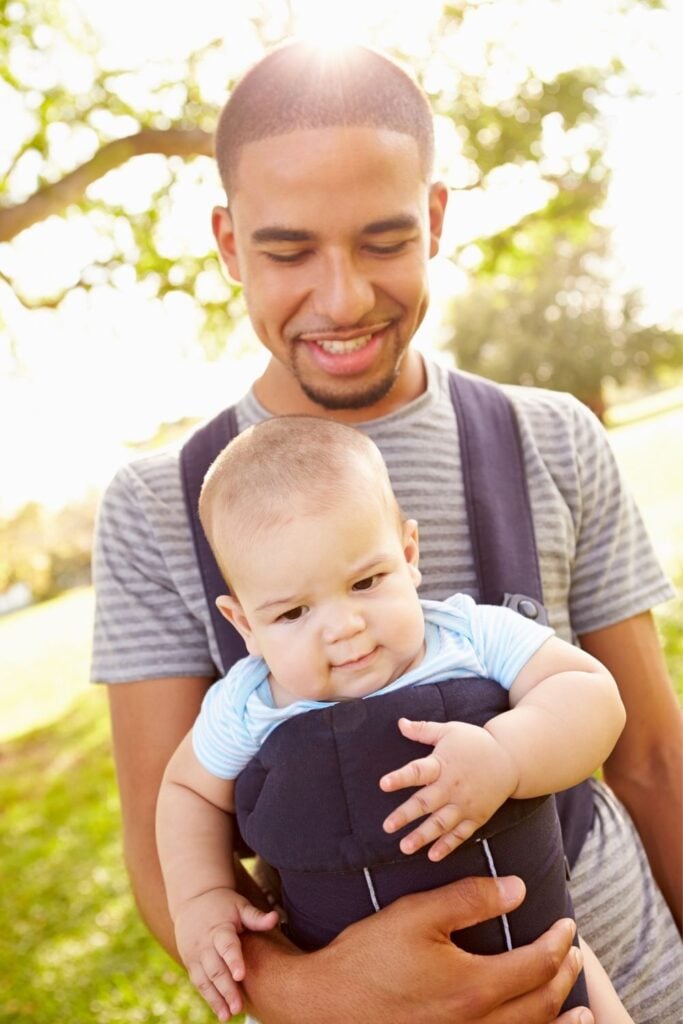
When is My Baby Ready to Face Forward While Babywearing?
Don’t rely on age to determine if your baby is ready to face forward. Instead, what matters is your baby’s developmental stage.
You can start considering the outward carry when your baby meets these criteria:
1. Their Neck is Strong Enough
Most babies develop strong enough neck and head muscles by the time they’re four to six months old, but this varies from baby to baby. You have to wait until your baby has full head control before using the outward position.
2. They are Tall Enough
Your baby has to be tall enough for his chin to sit above the top of the baby carrier panel.
Why You Might Not Want to Forward Face Your Baby
Many parents never use this carrier position for a variety of reasons. While it gives your baby a worldview and helps immerse them into the world around them, it also comes with some disadvantages that you want to consider.
Less Comfortable
One of the first things you will notice is that forward carrying isn’t as comfortable as facing your baby inward. This is because when you flip your baby outward, the center of gravity changes, and your baby’s weight pulls down, putting more strain on your shoulders and back.
If you already have shoulder or back problems, chances are forward-facing will make the discomfort worse.
Poor Positioning
Years ago, forward-facing was highly discouraged because no carriers put babies into the proper ergonomic position. These carriers led to babies feeling uncomfortable and pressure on the base of their spine.
Nowadays, this isn’t a real problem because many carriers keep your baby’s legs in the correct position.
Overstimulating for Baby
Overstimulation is an issue for babies, and while we want our babies to see the world, we don’t want them to experience TOO much.
When we forward face babies, they have no way to hide their faces or get away from the stimulation. Babies need breaks.
Poor Head and Neck Support
Forward-facing gives your baby no neck or head support. While parents should wait to forward face until their babies have adequate head control, sometimes, they still lose control of their heads when they’re young.
Which Baby Carriers Have Forward Facing Options?
This post contains affiliate links. See our full disclosure here
The Ergo 360 is an all in one carrier that grows with your baby from newborn to toddler (0-48 months; 7-45lbs). From forward facing in to forward facing out, hip and back carry it's hard to go past the versatility of this baby carrier!
We love it for forward facing baby wearing as it is easy to adjust and provides head & neck support for your baby. This is in additional to the padded lumbar back support and extra padded shoulder straps that provide maximum comfort.
The Omni 360 is so incredible for warm weather because it's made with soft, durable mesh fabric that keeps both you and your baby cool. It also has a detachable storage pouch and a UPF 50+ baby hood for sun protection and privacy.
Not all carriers forward face or have the proper support to do so. If this is an essential factor for you, you need to pick safe baby carriers.
The best carriers with high levels of ergonomic support include:
All of these carriers have bucket-shaped seats that support your baby in the proper ergonomic ‘M’ position, with their knees higher than their bottom.
Parents need to do their proper research. You’ll find many different carriers that advertise the ability to face forward, but you have to ensure they have the proper ergonomic support when facing inward and outward. Narrow bases are a sign that the carrier isn’t structured for this position.
You may also like our guide on the best plus size baby carriers!
How to Make Sure Baby is Sitting in An Ergonomic Position
Babies need to be seated in an ‘M’ shape with their knees above their hip sockets. The carrier should spread their legs wide to distribute their weight evenly and avoid excess pressure on their spines.
If you want to use a soft-structured carrier, ensure the seat provides adequate support and an ergonomic position. When using a wrap or a sling, the fabric must be spread across your baby’s bottom from knee to knee.
Here’s how to make sure your baby is in an ergonomic position.
- The carrier should support your baby’s legs from knee to knee; his legs shouldn’t dangle.
- The support should be by his thighs.
- His knees should be tucked up higher than his hips, with his pelvis tilted.
- The back should be slightly rounded.
Once your baby is in the carrier, put your hand on his bottom to check the seat width. Sometimes, carrier seats get folded, so you want to check from knee to knee.
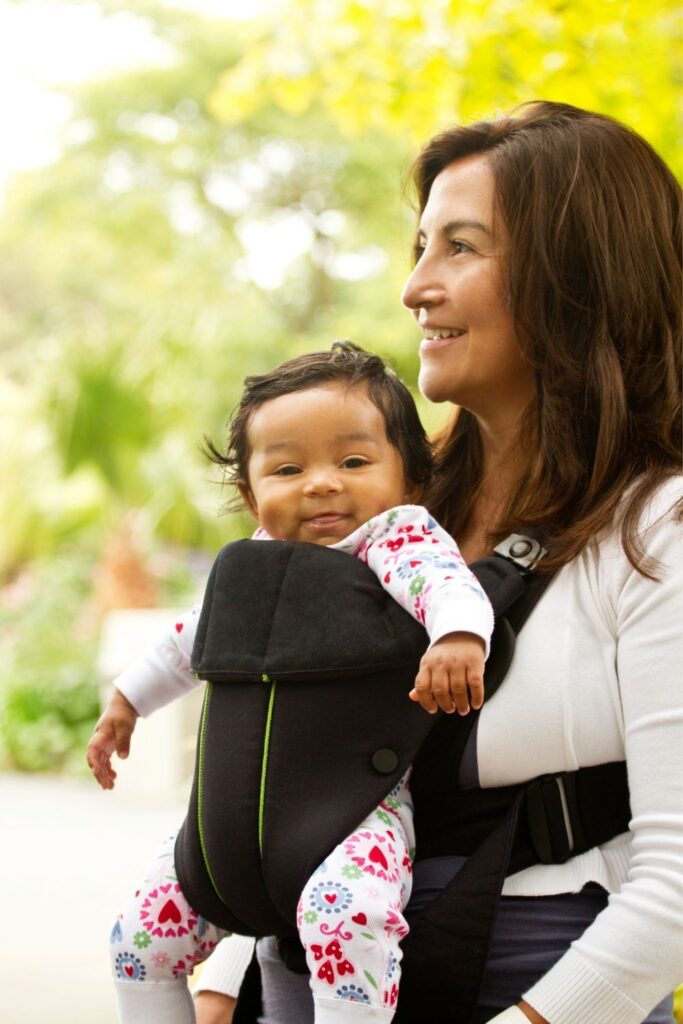
What Carriers Let You Forward Carry?
Not all baby carriers allow forward-facing, and remember, you should always read the manuals. In addition, some brands will tell you not to use their products forward-facing.
Soft-Structured Carriers
Soft-structured carriers, often abbreviated SSCs, have a structured seat and padded straps. Parents don’t have to use typing or wrapping; plastic buckles secure the baby carrier.
These are the most common types of carriers used when carrying forward. Manufacturers should tell you if this is a safe position for their carrier before you buy it.
Wraps
Baby wraps look like the most complicated type of carrier, but they’re incredibly comfortable once you figure it out. These carriers are long strips of fabric that you tie around your body to hold your baby in different positions.
Parents pick between two types of baby wraps:
1. Stretchy Wraps
Stretchy wraps are made from – surprise – stretchy fabric! These wraps are ideal for infants because heavier babies will pull and slacken the material.
2. Woven Wraps
These wraps are made of non-stretchy fabric. While it feels harder to master this type of baby carrier, they work for years up to preschool age.
Mei Tai
Sometimes called meh dai, these are similar to soft-structured carriers with a seat like the SSCs, but they have padded straps that need to be wrapped and secured around your baby rather than buckles.
Safety Recommendations for Facing Out While Babywearing
One of the biggest concerns when facing out while babywearing is that you will cause harm to your baby. Evidence shows that it’s unlikely that facing your baby outward for short periods will cause any damage, assuming the baby is strong enough to support their head and has proper hip support.
Here are some safety recommendations to follow to make sure your baby is happy and safe while babywearing.
1. Make Sure Your Baby is Ready
The first safety recommendation is always to make sure your baby is ready for that carrying position. It’s not safe for any baby under three months old; they don’t have sufficient neck and head control.
2. Check With Your Carrier First
Many carriers have a minimum weight requirement that varies based on make and model. Always check the manual of your baby carrier to determine when it’s recommended to start using the carrier and when it’s safe to begin facing out while babywearing.
3. No Sleeping!
One of the most critical safety recommendations is never to allow your baby to sleep facing outward in their carrier. Even if your baby has excellent head control, their heads lean forward when asleep.
That’s a serious problem that could prove potentially fatal. If babies’ heads fall forward, it closes off their airway.
4. Ergonomic Position Matters
The carrier you select needs to keep your baby’s hips spread out in a proper position for safety; make sure they don’t dangle straight downward. A baby’s joints take months to stretch out naturally after birth, and if you force their joints, they might become permanently damaged. It also dramatically increases the risk of hip dysplasia.
5. Only Use it for Short Periods
The facing out position is best saved for short periods. The longest you want to use this position is around 30 minutes. Not only do long periods end up overstimulating your baby, but chances are your back will start to hurt.
FAQs You Might Have about Forward Facing
When can a baby be forward facing in a carrier? You’ll be able to carry your baby forward facing, when your baby is at least four to six months old, can support their own head, and they meet the size requirements for the carrier.
Are forward facing baby carriers safe? Yes, forward facing baby carriers are safe provided that you follow some recommended safety precautions. These include making sure your baby is ready, your carrier is purpose built for forward facing, your baby does not sleep in the carrier, and you only use it for short periods of time.
Final Thoughts on When Can My Baby Face Forward in a Carrier
It’s safe for your baby to face forward in a carrier when he is between four and six months with good head and neck control.
However, don’t rush this position, and remember to use it for only short periods to avoid overstimulating your baby!
And if you’re looking for more great baby guides, then check out these guides on best baby carriers for hot weather, how long can you carry a baby in a carrier, best baby carriers for breastfeeding, and best baby wrap for summer.
